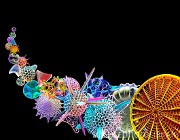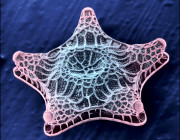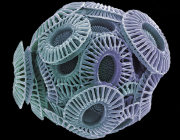Home :: List of Publicly Available Datasets :: Favella taraikaensis Fe Narragansett Bay
Favella taraikaensis Fe Narragansett Bay
Downloads:
| Principle Investigator(s) | Susanne Menden-Deuer |
|---|---|
| External sample ID | Heterocapsa + Fe |
| NCGR Sample ID | MMETSP0436 |
| Sample accession number | CAM_SMPL_002572 |
| Assembly accession number | CAM_ASM_000390 |
| Combined Assembly Name | Favella_taraikaensis_FeNarragansettBay |
| Genus | Favella |
| Species | taraikaensis |
| Strain | Fe Narragansett Bay |
| Clonal | Yes |
| Axenic | No |
| Prelim. NCBI Taxon ID | 626734 |
| 18S rRNA | |
| Importance of organism and transcriptomes | Blooms of toxic phytoplankton can negatively impact coastal ecosystems and economies through poisoning events that induce high mortality rates in fish (Landsberg 2002), birds (Shumway et al. 2003; Jessup et al. 2009), and illness in humans (Van Dolah et al. 2001). The success of the toxic raphidophite Heterosigma akashiwo partly depends on an interplay of high halotolerance and a reduction in predator induced mortality rates (Harvey & Menden-Deuer 2011). In a series of linked nominations, we investigate the genetic basis for the halotolerance of several predator and toxic algal strain. In combination, these transcriptomes would provide detailed information for hypothesis driven investigations into the puzzling success of this, and by implication, other HAB species. |
| Additional citations and references | |
| Environmental Data | |
| Primary citation for organism's characterization, if available | doi:10.4319/lo.2011.56.1.0371 |
| Latitude | 41.30051 |
| Longitude | -71.71543 |
| Depth (m) | 1 |
| Salinity (psu) | 30.68 |
| Collection date | 22-MAY-10 |
| Sample collection site | Atlantic_Ocean |
| Other collection site info | off shore of Quonochontaug Pond, Rhode Island |
| Sample material (e.g. "seawater," "sediment," etc.) | seawater |
| ENVO term for habitat - primary term | Acquatic: marine |
| Habitat | marine habitat |
| Country | UNITED STATES |
| Experimental Data | |
| Date of experiment | 16-DEC-11 |
| Growth medium | seawater |
| Modifications to growth medium | 0.2um filtered, autoclaved |
| Temperature (ºC) | 15 |
| Salinty (psu) | 29.4 |
| Light (µmol photons / m2 / sec) | 8 |
| Day portion of day:night cycle in hours | 12 |
| Night portion of day:night cycle in hours | 12 |
| Prey organism, if applicable (genus and species) | Heterocapsa triquetra, CCMP 448 |
| Investigation type | Eukaryotes |
| Other experimental metadata available | not axenic |








